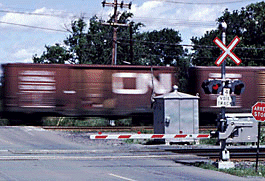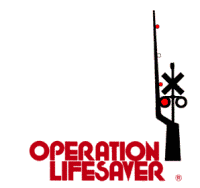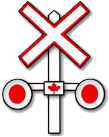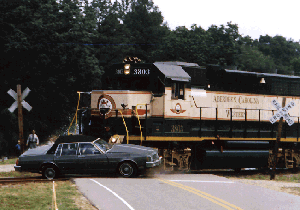
 Do you have railroad tracks and crossings in your
community? Baie d'Urfé has. The fatal accident to one of our young citizens
in February 1999 hit home the importance of railroad crossing safety knowledge. In
fact statistics show that there were 7 incidents on the Canadian National (CN) railway
track since 1980 within 5 miles of our crossing (Vaudreuil to Beaconsfield). Four
fatal accidents (two of them youths) occurred between February and April 1999 in this area
alone. The Canadian Pacific (CP) railway also has a crossing nearby with its own
record. In 1996 there were 48 people killed and 68 people seriously injured in
crossing incidents across Canada. These statistics do not indicate all the near
misses that occur very frequently by irresponsible people.
Do you have railroad tracks and crossings in your
community? Baie d'Urfé has. The fatal accident to one of our young citizens
in February 1999 hit home the importance of railroad crossing safety knowledge. In
fact statistics show that there were 7 incidents on the Canadian National (CN) railway
track since 1980 within 5 miles of our crossing (Vaudreuil to Beaconsfield). Four
fatal accidents (two of them youths) occurred between February and April 1999 in this area
alone. The Canadian Pacific (CP) railway also has a crossing nearby with its own
record. In 1996 there were 48 people killed and 68 people seriously injured in
crossing incidents across Canada. These statistics do not indicate all the near
misses that occur very frequently by irresponsible people.
This material can be used to fulfill partial requirements for
the Purple Star and Family
Safety Badge.
 Operation Lifesaver is a non-profit public information
program dedicated to eliminating injuries, fatalities and collisions at highway-rail
crossings and on railroad tracks and bridges. Accessing railway property can be very
dangerous. Remember to take care when you cross the tracks, and to always...
Operation Lifesaver is a non-profit public information
program dedicated to eliminating injuries, fatalities and collisions at highway-rail
crossings and on railroad tracks and bridges. Accessing railway property can be very
dangerous. Remember to take care when you cross the tracks, and to always...
 Look,
Listen, and Live!
Look,
Listen, and Live!
Awareness by Cub Scouts to Operation
Lifesaver is important for their safety and that of their friends, family and community.
Rules of the (Rail)Road
Never walk or drive around lowered gates. It is
illegal and deadly. If you suspect a signal gate is malfunctioning, call your local
law enforcement agency, the railroad, or dial 911.
NEVER race a train to the crossing. Even if you tie,
you lose.
Do not get trapped on a crossing. Only proceed
through a crossing if you are sure you can cross all of the track.
Get out of a vehicle you are in if it stalls on a crossing
and call your local law enforcement agency for assistance. Only attempt to restart if you
can post lookouts to warn of approaching trains.
Watch out for a second train when crossing multiple tracks.
Look BOTH ways before crossing
Expect a train on the track at any time. Trains do
not follow set schedules. Approaching trains can be VERY quiet.
If you are on a bicycle, stop and get off, look both ways,
listen and then walk your bike over the train tracks
Be aware that trains cannot stop quickly. It can take
a mile or more to stop once the emergency brakes are applied. When the engineer can
see you it is already too late to be able to avoid a collision.
Do not misjudge the train's speed and distance. A
train's large mass makes it impossible to accurately judge its speed and distance.
Trains cannot stop quickly:
150-car freight train approximate stopping distance
50 kph (30 mph) = 1.0 km (2/3 of a mile)
50 kph (80 mph) = 2.500 mm (1-1/2 miles)
8-car passenger train approximate stopping distance
100 kph (60 mph) = 1.0 km (2/3 of a mile)
125 kph (80 mph) = 1.8 km (1-1/8 miles)
 DO NOT walk, run, cycle or operate all bicycles, trail
bikes, snowmobiles or all terrain vehicles (ATVs) on railroad tracks and property or
through tunnels.
DO NOT walk, run, cycle or operate all bicycles, trail
bikes, snowmobiles or all terrain vehicles (ATVs) on railroad tracks and property or
through tunnels.
Cross tracks ONLY at designated pedestrian or roadway
crossings. Observe all warning signs and signals.
DO NOT hunt, fish or bungee jump from railroad bridges.
There is only enough clearance on tracks for a train to pass. They are not meant to
be sidewalks or pedestrian bridges.
DO NOT attempt to hop aboard railroad equipment at any
time. A slip of the foot can cost you a limb.
A person found guilty of trespassing on railway property
can face a fine of up to $10,000, to imprisonment for a term not exceeding one year, or
both.
Be aware that trains DO NOT follow set
schedules. Any Time is Train Time!
 REMEMBER: Rails and Recreation DO
NOT Mix!
REMEMBER: Rails and Recreation DO
NOT Mix!
 Railroads such as Canadian National (CN) and Canadian Pacific (CP) participate in
Operation Lifesaver, a public education program about level crossing safety and the
hazards of trespassing on railway tracks.
Railroads such as Canadian National (CN) and Canadian Pacific (CP) participate in
Operation Lifesaver, a public education program about level crossing safety and the
hazards of trespassing on railway tracks.
 Since Operation Lifesaver was launched in 1980 by the Railway
Association of Canada and Transport Canada, the number of level crossing accidents on all
railways in Canada has been reduced by more than 50 percent. Similar reductions have
been seen in the number of fatalities and injuries resulting from these accidents.
Since Operation Lifesaver was launched in 1980 by the Railway
Association of Canada and Transport Canada, the number of level crossing accidents on all
railways in Canada has been reduced by more than 50 percent. Similar reductions have
been seen in the number of fatalities and injuries resulting from these accidents.
 Railroad
companies make special effort to bring safety into the communities through which they
travel. The railroads participate in safety displays and presentations in communities
across Canada and the US, including special programs for schools or community
organizations such as Scouting, to teach about safety near tracks and level crossings.
Railroad
companies make special effort to bring safety into the communities through which they
travel. The railroads participate in safety displays and presentations in communities
across Canada and the US, including special programs for schools or community
organizations such as Scouting, to teach about safety near tracks and level crossings.

 You can find out more about this program on the
Canadian, CN,
CP
or US web site which is dedicated to the
topic. At the Lifesaver site you can find training material and interesting things for the Cubs to do to become
more aware and act more responsible around railway tracks.
You can find out more about this program on the
Canadian, CN,
CP
or US web site which is dedicated to the
topic. At the Lifesaver site you can find training material and interesting things for the Cubs to do to become
more aware and act more responsible around railway tracks.